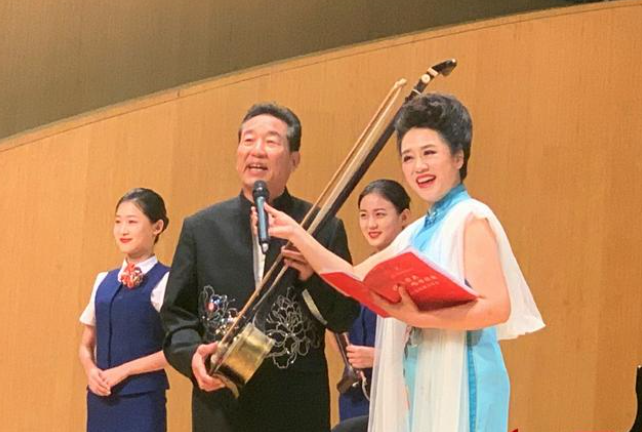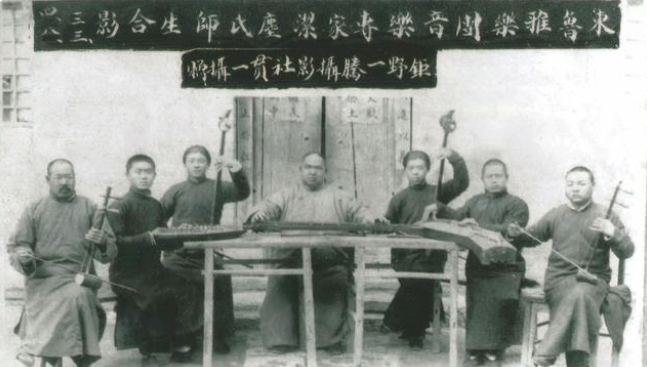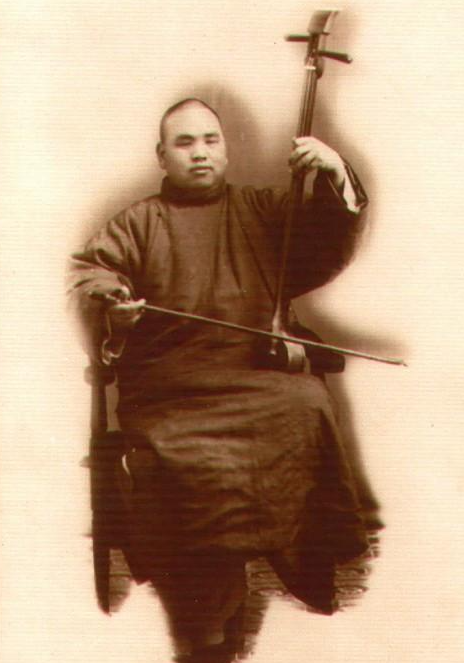The art of reqin that can be sung onomatopoeia is a "wonderful flower" in the national string music
Leiqin, originated in Heze, draws on the strengths of many families to form a unique performance method that combines instrumental and vocal music, performance and imitation. It has been continuously carried forward and inherited by generations of Leiqin artists. It has become an indispensable part of the Chinese national stringed musical instruments. Recently, the Shandong Provincial People's Government announced the fifth batch of representative projects of provincial intangible cultural heritage. On December 2, the all-media reporters of Peony Evening News visited a number of quyi artists in our city who knew about "Leiqin Art" and inherited "Leiqin Art", and deeply understood the charm of "Leiqin Art".

Inherited for a hundred years, the distinctive Leiqin art endures for a long time
At 9:00 in the morning, all-media reporters from Peony Evening News came to the home of Su Bendong, the former chairman of the Heze Quyi Artists Association, the founder of the Qinzheng Qingqu Guyue Society, and the provincial intangible inheritor of Heze Xiansuole. Since its establishment in 2011, the Qinzheng Qingqu Guyue Society founded by Su Bendong, a social organization for the bequeathing declaration, has organized and restored a large number of Heze string and cable music, traditional Guzheng music and brand music of Qinzheng Qingqu, and created and adapted a batch of new songs. It is the only mature string orchestra in the country at present.
Su Bendong has a deep knowledge and understanding of the "leiqin art". He said that Heze has a long history and a splendid culture. There are many kinds of material and intangible cultural heritage, which are broad and profound. "The Leiqin is one of the most distinctive and distinctive musical instruments among the Chinese national stringed instruments. It was developed on the basis of the Shandong folk falling qin and has a history of more than 100 years. The founding of the Leiqin art Mr. Wang Dianyu, an outstanding folk musician, is from Xuqiao Village, Yuncheng County, Heze."

"The Leiqin was developed on the basis of the pendant, but compared to the pendant, the speaker of the Leqin was changed from wood to copper, the skin was also changed to python skin, the stem became longer, and both sides of the headstock were made longer. Each set has one shaft, two strings, placed on the bridge, and the ponytail bow is played between the two strings. When playing, a unique single-finger pressing method is adopted, which has a wider range of sounds, but the requirements for the artist's skills are stricter." In-depth. Su Bendong, who has learned about the art of Leiqin, introduced to all media reporters of the Peony Evening News, "In the process of its spread and development, the art of Leiqin has been integrated with local opera, folk art and folk music, and gradually formed instrumental and vocal music, performance and imitation. The combined performance method is unique in Chinese and foreign instrumental music.”

The reqin art created by Wang Dianyu and his ingenious performance of that day became popular at home and abroad in the 1920s. "He started from Jinan and traveled south and north many times. He played the reqin and absorbed the strengths of various folk art along the way, and made the art and skills of the reqin more and more perfect. It was able to quickly become popular in China.” Su Bendong said, “He sang operas imitated by the thunder qin, as well as the natural sounds such as people crying and laughing, and animal chirping. The Peking Opera master Mei Lanfang heard Wang Dianyu simulate the thunder Qin. After singing the song "Second Entering the Palace", he said: "You pull it, it sings better than me."
In 1944, Wang Dianyu returned to his hometown of Heze and founded the Dongluya Orchestra. While immersed in his body and mind, he led the orchestra to perform in surrounding provinces and cities, and exchanged all the money for food, and opened a porridge shed to help those displaced by the war. Chinese.
The art of reqin is rooted in the cultural fertile soil of national folk music. With its unique aesthetic character and high academic value, artistic value and appreciation value, it has won the attention of the music industry and the welcome of domestic and foreign audiences. Wang Dianyu's descendants, Zhao Yuzhai, Han Fengtian, Wang Fuli, Zhao Dandan, etc., have visited and performed in the United States, France, Germany and other countries, as well as Hong Kong, Taiwan and other regions for many times. The China Conservatory of Music, the Central Conservatory of Music and other major music institutions all take the art of reqin as a compulsory subject, and have held many reqin concerts and academic seminars at home and abroad.

Talents wither, how to effectively inherit and carry forward
To talk about the inheritance of Leiqin art in Heze, we have to mention Hu Huashan, the fourth-generation descendant of Heze Leiqin art. At about 11 o’clock, I remembered that I drove to Hu Huashan’s house. Before entering the house, the reporter heard a while outside the window. The sound of Leiqin playing, "When there is no performance, I usually practice at home, referring to the repertoire and audio-visual products of Patriarch Wang Dianyu, as well as the playing videos of domestic colleagues, so as to deepen my understanding while learning." Hu Huashan told reporters.

Speaking of Leiqin, Hu Huashan suddenly opened the conversation box, "When I was studying with my master Zhao Danden, the master said that the art of Leiqin was on the verge of being lost. It is very fast to learn the reqin, but the more you learn, the more you discover the unique charm of the reqin that is different from other musical instruments.”
According to Hu Huashan, the Leiqin has various performance techniques. It consists of two strings, which are divided into inner strings and outer strings. The two strings are switched back and forth when playing. The stem is like a three-stringed fingerboard, and the barrel is like a huqin. It is played with a bow. The timbre is close to the human voice, sometimes like a woman crying and complaining, sometimes like a male voice, sometimes like a cock crowing and a dog barking, the art of performance is unique in the field of instrumental music.

"Through the efforts and explorations of several generations of Leiqin artists, Leiqin art has formed its unique performance techniques, accumulated a large number of repertoires, and left a rich musical wealth for future generations. All kinds of opera arias, popular songs, various sounds in life and nature, as well as instrumental music of different local styles and transplanted Western works." Hu Huashan said, "It imitates the arias of famous Peking Opera masters, it is vivid and imitates People's words cry and laugh, animals chirping, Shengguan suona, gongs and drums bugles, etc. can be misleading."
"It is no exaggeration to say that Leiqin art is a wonderful flower of national music culture." Hu Huashan said, "In addition to the traditional solo performance, Heze has also developed a form of ensemble with other silk strings. The basic musical instruments include Guzheng, Yangqin, Pipa, Ruyigou, Zheqin, Soft Bow Hu, Erhu, Banhu, etc. For example, the modernly created string and cable pieces such as "Hometown Music" and "Xi Yun" are all reflected."
When it comes to inheritance, Hu Huashan said that it is a mixed blessing that Leiqin art has been included in the list of the fifth batch of provincial-level representative projects of intangible cultural heritage. "Heze is the birthplace of Leiqin, and this time it was awarded a provincial-level intangible cultural heritage project, which shows that the government attaches great importance to and intends to support it, and I am very happy." Having said this, Hu Huashan was a little immersed in it, "but now there are artistic talents. Withering, especially few young people are willing to learn, I have only one apprentice Kong Lushun who has officially taken over the Leiqin Art, and he is busy with his livelihood all day long. I think that the protection of intangible cultural heritage projects is first and foremost for talents. With love and support, in the next step, I plan to jointly hold a national Leiqin art training class with some old domestic artists to increase inheritance and influence more young people to carry forward Leiqin art."
Regarding the inheritance and protection of the Leiqin, Su Bendong said that the next step will be to use his Qinzheng Qingqu Gu Yue Society and many domestic Leiqin artists to increase the holding of Leiqin art training classes, Leiqin art exchange and learning activities, and excavate and collect Leiqin art. , Arranging the musical scores and video materials of the reqin art, establishing a systematic file, and planning to publish a book on the origin, inheritance, and repertoire of the reqin art for future generations to learn and reference.
 渝公网安备 50010702504639号
渝公网安备 50010702504639号